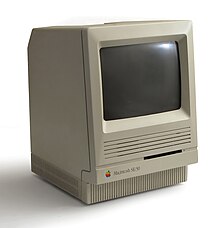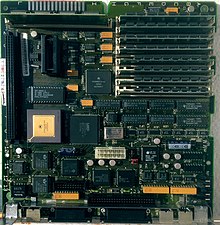| This article relies excessively on references to primary sources. Please improve this article by adding secondary or tertiary sources. Find sources: "Macintosh SE/30" – news · newspapers · books · scholar · JSTOR (May 2023) (Learn how and when to remove this message) |
 | |
| Manufacturer | Apple Computer |
|---|---|
| Product family | Compact Macintosh |
| Type | All-in-one |
| Release date | January 19, 1989; 35 years ago (1989-01-19) |
| Introductory price | US$4,369 (equivalent to $10,740 in 2023) |
| Discontinued | October 21, 1991; 33 years ago (1991-10-21) |
| Operating system | System 6.0.3 – System 7.5.5 With a 32-bit clean ROM upgrade, Mac OS 7.6 - Mac OS 8.1, A/UX |
| CPU | Motorola 68030 @ 15.667 MHz Motorola 68882 FPU |
| Memory | 1 MB RAM, expandable to 32 MB (120 ns 30-pin SIMM) |
| Display | 9 in (23 cm) monochrome, 512 × 342 |
| Dimensions | Height: 13.6 in (35 cm) Width: 9.6 in (24 cm) Depth: 10.9 in (28 cm) |
| Weight | 19.5 lb (8.8 kg) |
| Predecessor | Macintosh SE |
| Successor | Macintosh Classic Macintosh Classic II |
| Related | Macintosh IIx Macintosh IIfx Macintosh II Macintosh IIcx Macintosh IIci Macintosh Portable |
The Macintosh SE/30 is a personal computer designed, manufactured and sold by Apple Computer from January 1989 to October 1991. It is the fastest of the original black-and-white compact Macintosh series.
The SE/30 has a black-and-white monitor and a single Processor Direct Slot (rather than the NuBus slots of the IIx, with which the SE/30 shares a common architecture) which supported third-party accelerators, network cards, or a display adapter. The SE/30 could expand up to 32 MB of RAM (a significant amount of RAM at the time), and included a 40 or 80 MB hard drive. It was also the first compact Mac to include a 1.44 MB high density floppy disk drive as standard (late versions of the SE had one, but earlier versions did not). The power of the SE/30 was demonstrated by its use to produce the This Week newspaper, the first colour tabloid newspaper in the UK to use new, digital pre-press technology on a personal, desktop computer.
In keeping with Apple's practice, from the Apple II+ until the Power Macintosh G3 was announced, a logic board upgrade was available for US$1,699 to convert a regular SE to an SE/30. The SE would then have exactly the same specs as an SE/30, with the difference only in the floppy drive if the SE had an 800 KB drive. The set included a new front bezel to replace the original SE bezel with that of an SE/30.
Although this machine was succeeded in Q4 of 1990 by the Macintosh Classic, the SE/30 wasn't discontinued until 1991 by the Macintosh Classic II, which despite featuring the same processor and clock speed, was only 60% as fast as the SE/30 due to its 16-bit data path, supported no more than 10 MB of memory, lacked an internal expansion slot, and made the Motorola 68882 FPU an optional upgrade.
Hardware

Although the Motorola 68030 in the SE/30 supports 32-bit addressing, the SE/30 ROM, like the IIx ROM, includes some code using 24-bit addressing, rendering the ROM "32-bit dirty". This limits the actual amount of RAM that can be accessed to 8 MB under System 6.0.8. A system extension called MODE32 enables access to installed extra memory under System 6.0.8. Under System 7.0 up to System 7.5.5 the SE/30 can use up to 128 MB of RAM. Alternatively, replacing the ROM SIMM with one from a Mac IIsi or Mac IIfx makes the SE/30 "32-bit clean" and thereby enables use of up to 128 MB RAM and System 7.5 through OS 7.6.1.
A standard SE/30 can run up to System 7.5.5, since Mac OS 7.6 requires a "32-bit clean" ROM.
Additionally, the SE/30 can run A/UX, Apple's older version of Unix that was able to run Macintosh programs.
Though there was no official upgrade path for the SE/30, several third-party processor upgrades were available. A 68040 upgrade made it possible to run Mac OS 8.1, which extended the SE/30's productive life for many more years. Also extending the useful life of the SE30 were Micron Technology video cards. Three cards were available, which fit into the SE/30's Processor Direct Slot: the 8-bit Gray-Scale 30, the SE/306-48, 640x480 resolution 8-bit color, and SE/3010-78 1024x768 resolution 8-bit color. With the first, the internal display was 8-bit greyscale; the latter two were used with 13" and 14", respectively, external color monitors, while retaining 1-bit (black and white) on the internal monitor.
Models
- Macintosh SE/30: Available in multiple configurations.
- US$4,369 (equivalent to $10,740 in 2023): 1 MB RAM, No hard disk
- US$4,869 (equivalent to $11,970 in 2023): 1 MB RAM, 40 MB hard disk
- US$6,569 (equivalent to $16,150 in 2023): 4 MB RAM, 80 MB hard disk
Reception
Nick Baran of BYTE in February 1989 approved of the SE/30's performance improvements over the SE and II, stating that the only reasons to instead buy a IIx were the latter's NuBus slots and official support for A/UX. Bruce F. Webster wrote in Macworld in March 1989 that the SE/30 did not "break new ground. It does, however, establish Apple's commitment to the classic Mac product line, and it provides users with an Apple-supported alternative to either a small, slow Mac or a large, powerful one. More important, it fills a gap in the Macintosh family ... a new level of power and portability for the Macintosh community".
In a January 2009 Macworld feature commemorating the 25th anniversary of the Macintosh, three industry commentators – Adam C. Engst of TidBITS, John Gruber of Daring Fireball, and John Siracusa of Ars Technica – chose the SE/30 as their favorite Mac model of all time. "Like any great Mac," wrote Gruber, "the SE/30 wasn't just a terrific system just when it debuted; it remained eminently usable for years to come. When I think of the original Mac era, the machine in my mind is the SE/30."
The SE/30 remains popular with hobbyists, and has been described as “the best computer Apple will ever make,” with used models selling for a significant premium relative to other machines of the era. Contemporary PDS upgrades allowed an SE/30's internal monitor to be upgraded to support 256 shades of gray (the only original-design Macintosh to support such an upgrade) or a 68040 processor, and the SE/30's standard RAM limit of 128 MB greatly exceeded even that of much later models such as the Color Classic and Macintosh LC II. In 2018, add-ons and software became available to add WiFi and even make the SE/30 work as a remote control for Spotify.
In popular culture
In the NBC TV series Seinfeld, Jerry has an SE/30 sitting on the desk of his apartment during the first few seasons. This would be the first of many Macs to occupy the desk, including a PowerBook Duo and a Twentieth Anniversary Macintosh.
In the FX series It's Always Sunny in Philadelphia, the Waitress is seen with a Macintosh SE/30 on her bedroom desk in the episode "The Gang Gives Back".
In the film Watchmen, Ozymandias has an all-black TEMPEST-shielded SE/30 on his desk.
Timeline
| Timeline of Compact Macintosh models |
|---|
 See also: List of Mac models and Compact Macintosh
See also: List of Mac models and Compact Macintosh
|
References
- "Mac Classic II, a Compromised Mac". Low End Mac. March 12, 2014. Archived from the original on August 27, 2019. Retrieved August 27, 2019.
- Pogue, David; Schorr, Joseph (1999). MacWorld Mac Secrets, 5th Edition. IDG Books. pp. 461-462. ISBN 0-7645-4040-8.
- "25 Years of the Mac SE/30". Low End Mac. January 19, 2014. Archived from the original on August 27, 2019. Retrieved August 27, 2019.
- "Lowendmac". Archived from the original on July 2, 2015. Retrieved July 2, 2015.
Minimum requirements for Mac OS 7.6 included a 68030 CPU, "32-bit clean" ROMs, 8 MB of RAM (12-16 MB recommended), and 70 MB of hard drive space. It no longer supported 24-bit addressing or classic Mac networking (it used OpenTransport exclusively).
- "A/UX FAQ". Archived from the original on October 8, 2011. Retrieved July 2, 2015.
A/UX 3.0 works on the Mac II (with PMMU or 68030 upgrade with FDHD ROM's installed), IIx, IIcx, IIci, IIfx, SE/30, IIsi (with 68882 chip) and the Quadra 700/900/950 computers.
- "SE/30 GrayScale ScreenShots". Archived from the original on June 12, 2002. Retrieved July 20, 2020.; "Micron Xceed for Mac SE/30". Low End Mac. September 2, 1999. Archived from the original on August 11, 2019. Retrieved August 11, 2019.; "Xceed SE/306-48" (PDF). August 15, 2023. Archived (PDF) from the original on October 31, 2022. Retrieved March 28, 2023.
- "Macintosh SE/30: Technical Specifications". Apple. Archived from the original on January 9, 2015. Retrieved October 16, 2017.
- "Mac flashback: Original InfoWorld review of the Macintosh SE/30 (3/27/1989)". InfoWorld. January 24, 2014. Archived from the original on July 3, 2015. Retrieved July 2, 2015.; Green, Doug; Green, Denise (March 27, 1989). "Mac SE/30 Leapfrogs Past 68020 Generation of CPUs". InfoWorld. Vol. 11, no. 13. pp. 71–73. Archived from the original on September 20, 2022. Retrieved October 28, 2021.
- Baran, Nick (February 1989). "The Mac SE Takes Off". BYTE. pp. 113–116.
- Webster, Bruce F. (March 1989). "The Mac SE Turns 030". Macworld. Vol. 6, no. 3. pp. 112–117. Retrieved August 20, 2016.
- ^ Benchoff, Brian (September 26, 2018). "Apple's Best Computer Gets WiFi". Hackaday. Archived from the original on August 10, 2019. Retrieved August 10, 2019.
- "Micron Xceed for Mac SE/30". Low End Mac. September 2, 1999. Archived from the original on August 11, 2019. Retrieved August 11, 2019.
- Coward, Cameron (December 26, 2018). "A Macintosh SE/30 Spotify Music Player". Medium. Archived from the original on September 20, 2022. Retrieved August 10, 2019.
- Warren, Christina (June 23, 2015). "Hulu's 'Seinfeld' apartment is now perfect". Mashable. Retrieved January 1, 2025.
- Diaz, Jesus (March 6, 2009). "Watchmen's Old School Macintosh SE/30". Gizmodo. Archived from the original on July 2, 2012. Retrieved September 2, 2020.
| Apple hardware before 1998 | |||||||||||||||||
|---|---|---|---|---|---|---|---|---|---|---|---|---|---|---|---|---|---|
| Computers |
| ||||||||||||||||
| Peripherals |
| ||||||||||||||||
| See also template: Apple hardware since 1998 | |||||||||||||||||